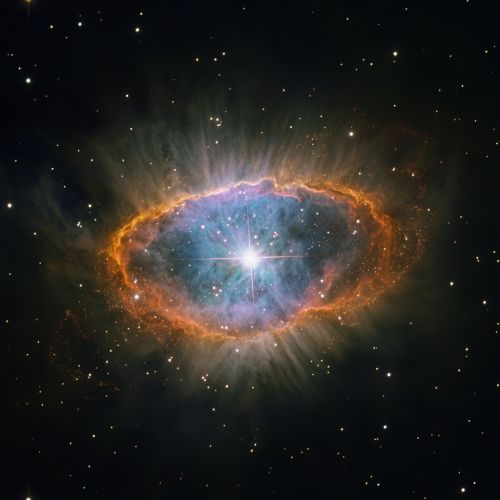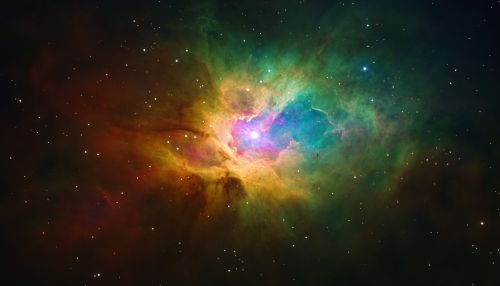NGC 2438
Overview
NGC 2438 is a planetary nebula located within the boundaries of the constellation Puppis. It was discovered by the renowned astronomer William Herschel in 1786. This celestial object is situated approximately 3,000 light-years away from Earth. NGC 2438 is often associated with the open star cluster Messier 46, although it is not physically related to it. The nebula is an excellent example of a planetary nebula, showcasing the final stages of stellar evolution for a star similar in mass to our Sun.


Physical Characteristics
NGC 2438 exhibits a classic ring-shaped structure typical of many planetary nebulae. The nebula's diameter is approximately 1.1 light-years, and it is expanding at a rate of about 37 kilometers per second. The central star of NGC 2438, which is responsible for the ionization of the surrounding gas, is a white dwarf with a surface temperature exceeding 75,000 Kelvin. This high temperature is crucial for emitting the ultraviolet radiation necessary to illuminate the nebula.
The nebula's spectrum is dominated by emission lines, particularly those of hydrogen, helium, and oxygen. The presence of doubly ionized oxygen ([O III]) gives NGC 2438 its characteristic greenish hue when observed through telescopes equipped with appropriate filters. The nebula's morphology and spectral characteristics provide insights into the chemical composition and physical processes occurring within the nebula.
Formation and Evolution
Planetary nebulae like NGC 2438 form during the late evolutionary stages of intermediate-mass stars. As these stars exhaust their nuclear fuel, they expel their outer layers into space, creating an expanding shell of gas. The remaining core of the star becomes a white dwarf, which emits intense ultraviolet radiation that ionizes the ejected material, causing it to glow.
The process of nebula formation is influenced by several factors, including the initial mass of the progenitor star, its metallicity, and the presence of magnetic fields. In the case of NGC 2438, the progenitor star likely had a mass between 1 and 8 solar masses. The nebula's current appearance is shaped by interactions between the stellar wind from the central star and the surrounding interstellar medium.
Relationship with Messier 46
NGC 2438 appears superimposed on the open cluster Messier 46, leading to the misconception that they are physically associated. However, spectroscopic studies and distance measurements have shown that NGC 2438 is located at a different distance from Messier 46, indicating that the two objects are not gravitationally bound. This alignment is merely a line-of-sight coincidence.
The apparent proximity of NGC 2438 to Messier 46 provides a unique observational opportunity to study the nebula against the backdrop of a rich star cluster. This juxtaposition allows astronomers to explore the dynamics and interactions of celestial objects within the same field of view.
Observational History
Since its discovery by William Herschel, NGC 2438 has been the subject of numerous observational studies. Early observations focused on its morphology and brightness, while more recent studies have utilized advanced techniques such as spectroscopy and imaging with space-based telescopes.
The Hubble Space Telescope has provided high-resolution images of NGC 2438, revealing intricate details of its structure and shedding light on the processes governing its evolution. Observations across different wavelengths, from radio to X-rays, have contributed to a comprehensive understanding of the nebula's physical properties and its interaction with the surrounding environment.
Scientific Significance
NGC 2438 serves as a valuable laboratory for studying the late stages of stellar evolution and the processes involved in the formation of planetary nebulae. Its well-defined structure and proximity make it an ideal target for detailed spectroscopic and photometric studies. By analyzing the light emitted by NGC 2438, astronomers can infer the chemical composition of the nebula and gain insights into the nucleosynthesis processes that occurred in the progenitor star.
Furthermore, NGC 2438 provides an opportunity to study the dynamics of expanding nebulae and the role of magnetic fields in shaping their morphology. The nebula's interaction with the interstellar medium offers clues about the distribution and density of material in the surrounding region.
Challenges and Future Research
Despite the wealth of information obtained from observations of NGC 2438, several challenges remain in fully understanding its nature. One of the primary challenges is accurately determining the distance to the nebula, which is essential for calculating its physical size and luminosity. Discrepancies in distance measurements have led to uncertainties in the derived properties of NGC 2438.
Future research efforts will likely focus on improving distance estimates using techniques such as parallax measurements and modeling the nebula's expansion. Additionally, advances in computational modeling and simulations will enhance our understanding of the processes driving the formation and evolution of planetary nebulae like NGC 2438.
